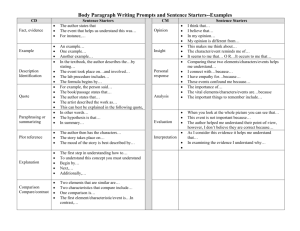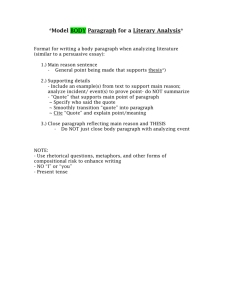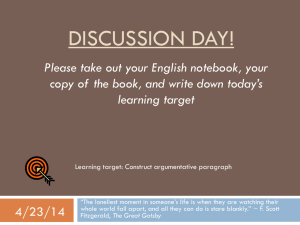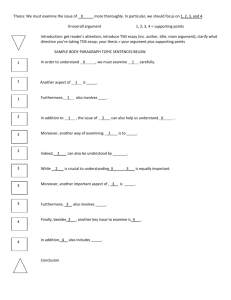How to Write an Effective Essay
advertisement
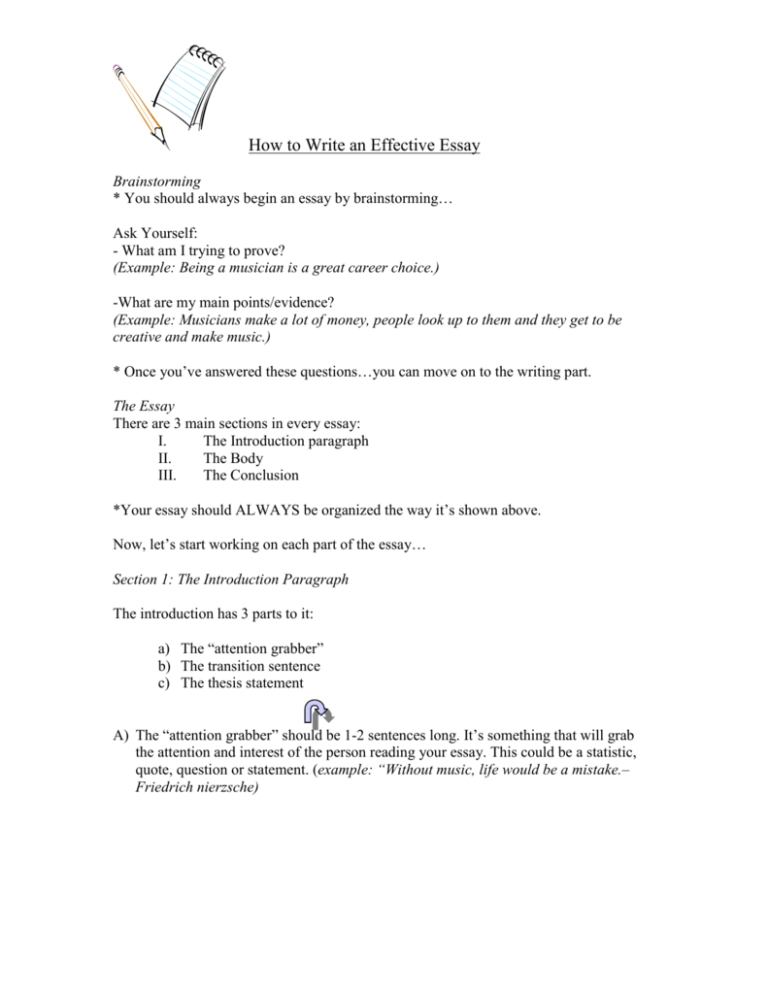
How to Write an Effective Essay Brainstorming * You should always begin an essay by brainstorming… Ask Yourself: - What am I trying to prove? (Example: Being a musician is a great career choice.) -What are my main points/evidence? (Example: Musicians make a lot of money, people look up to them and they get to be creative and make music.) * Once you’ve answered these questions…you can move on to the writing part. The Essay There are 3 main sections in every essay: I. The Introduction paragraph II. The Body III. The Conclusion *Your essay should ALWAYS be organized the way it’s shown above. Now, let’s start working on each part of the essay… Section 1: The Introduction Paragraph The introduction has 3 parts to it: a) The “attention grabber” b) The transition sentence c) The thesis statement A) The “attention grabber” should be 1-2 sentences long. It’s something that will grab the attention and interest of the person reading your essay. This could be a statistic, quote, question or statement. (example: “Without music, life would be a mistake.– Friedrich nierzsche) B) The Transition sentence is just something to go between your attention grabber and your thesis statement. It basically explains your attention grabber. (Example: Music is a very important part of our live, and the people who make music are very special in this world.) C) The thesis statement is THE MOST IMPOTANT PART OF YOUR ESSAY! The thesis statement says what you are trying to prove and gives your reasons behind it. It’s good to follow the format of -----because----, ---, ---. If you are writing about a book you should state the title and author of the book in this sentence. (Example: being a musician is a great career because the salary is good, a lot of people admire you and it brings out you creativity.) * So, just put the 3 parts above together…and have your introduction paragraph!! Section 2: The Body The body consists of paragraphs that talk about the things you stated in your thesis statement. You should have about 1 or 2 paragraphs for each of the reasons in your thesis statement. So, if your thesis statement is Being a musician is a great career because the salary is good, a lot of people admire you and it brings out your creativity. Then, you will have a least… - 1 paragraph talking about the good salary. - 1 paragraph talking about how people admire you - 1 paragraph talking about how being a musician brings out your creativity. *In these paragraphs you are going to give facts, statistics, opinions, and data. You basically just the reader proof for why you gave that reason. Don’t forget NOT TO PLAGIARIZE. Plagiarize means to copy something from somebody else and not give credit to that person. This is illegal and you can remove from school for doing this. You give credit to a person by putting quotations (“…”) around what they said and by putting their name with it somewhere-either in the beginning or at the end. Example: “The Princeton Review states that the average salary of a musician is 50,000.” Or “The average salary of a musician is $50,000” [Princeton Review] *Now, let’s work on how to write the paragraph for the body… - The reader can clearly see that…. - The Princeton review was clearly stating that… - The above statistic shows that… (Example: The above statistic shows that most musicians earn about $50,000 per year, but this is after they have been in the music industry for about 10-15 years) V. THE EXPLANATION OF THE QUOTE You should always explain a quote to the reader. After you transition out of the quote, you basically put the quote into your own words and explain it. (Example: the above statistic shows that most musicians earn about $50,000 per years, but this is after they have been in the music industry for about 10-15 years. VI. THE CLOSING STATEMENT You should always close and conclude your paragraph with about 1 to 4 sentences. These are basically going to summarize the main points of your paragraph and transition into the next paragraph. You can feel free to state an opinion in these statements. (Example: although musicians earn an average salary of about $50,000, this is only after 10-15 years of being in the music industry. Before they reach this salary, most musicians probably struggle just to make ends meet and pay the bills. And yet, there are many other reasons, besides salary, of why a person would want to be a musician. One of those reasons is the admiration of people all over the world.) * So, just put all of the parts above together…and you have a paragraph. Do this for all the paragraphs in your body. Section 3: The conclusion For the conclusion, you are basically just going to re-state your introduction paragraph into different words. This paragraph is suppose to just “wrap-up” and summarize you whole paper. You can state your opinion in this paragraph. This paragraph should no include any quotes or any new subject/topics and should be about 4 to 5 sentences long. If you are writing about a book, don’t forget to re-state the title and author of the book in this paragraph. (Example of how to re-stateOriginal thesis statement in INTRODUCTION paragraph: being a musician is a great career because the salary is good, a lot of people admire you and it brings out your creativity. New thesis statement is CONCLUSION paragraph: Working in the music industry as a musician has a lot of benefits. Some of these benefits are a high salary, the admiration of the public and the fact that being a musician requires you to use your creativity. How a paragraph is structured: A paragraph has 6 parts to it: I. II. III. IV. V. VI. The opening statements The transition INTO a quote The Quote The transition OUT OF the quote The explanation of the quote The closing statements * You should always try to follow the above format. I. OPEINING STATEMENTS The opening statements just briefly state what your main point for the paragraph is going to be. The opening statements should be about 1 to 2 sentences. (Example: Musicians, on the average, earn a very good salary.) II. THE TRANSITION INTO A QUOTE When you add a quote or statistic to your paragraph, you should have to introduce it somehow…this is called a transition onto a quote. Some transitions that you can use are: - The author states…” - The Author explains…” - The writer describes… - The Princeton Review states…” - Hamlet thinks to himself…” (Example: The Princeton Review states that the average musician earns about $50,000 per year after 10-15 years.) III. THE QUOTE After the transition, you add your quote, statistic or whatever data you have to prove your point. (Example: The Princeton Review states that the average musician earns about $50,000 per year after 10-15 years.) IV. THE TRANSITION OUT OF THE QUOTE After your quote, you are going to need to explain the quote; you transition OUT OF your quote and into an explanation by using some of these transitions: As you can see from the above quotation… The above quotation clearly shows that…


